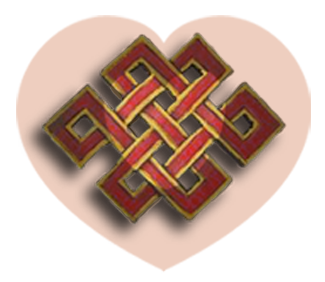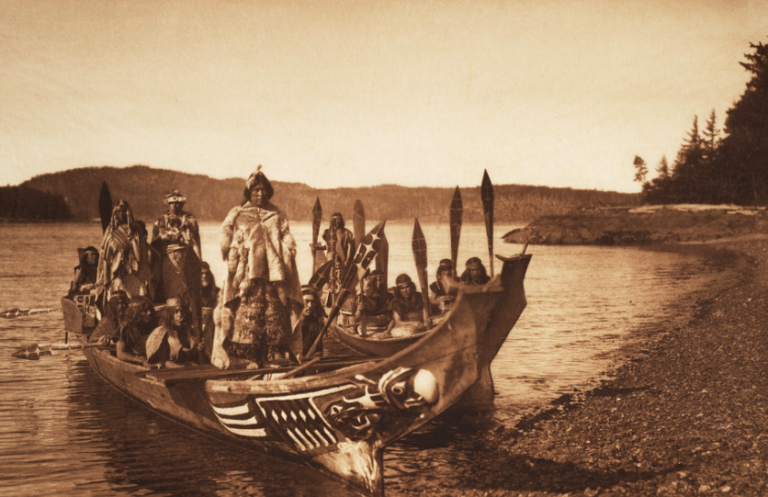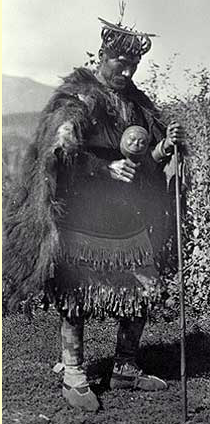Shamanism & Divination Amongst Tribes of the North Pacific Coast Region
My intention in researching this topic is two-fold. I was born in Seattle, Washington and spent much of my life in the San Juan Islands. North American Indian lore is rich in those parts. Most of the region’s many rivers and mountains are named after Northwest tribes. Totem poles and Tlingit art were a part of my upbringing, as were salmon, seals, orca whales, eagles, crows and horses.
My first cognitive interest as a child was to learn and mimic the northwest Indian ways. At a young age I learned about native edibles and harvested roots, berries, bark and seeds. I had horses, wore fringe, and learned the history of Northwest tribes.
This expanded me into a worldview that includes all beings, past, present and future. Because of this engagement in a more circular than linear concept of time, the practice of divination made sense to me. In my twenties I studied various forms of divination mostly from the Taoist tradition, but it was not until meeting my lama Dhubthob Rinpoche and through him later, the Nechung Oracle, that my studies of divination began to expand.
Now in my early ’50’s, I have vowed to deepen my roots to my place of origin. My exploration of the divination methods of the tribes of the Pacific Northwest has gifted me with a full-circle deepening of soul, heart and mind.
The Northwest is rich in flora and fauna, and provided a place of wealth for the many tribes that lived there. The North Pacific Coast Region has been defined and redefined by many early explorers and researchers of Native Tribes. At the forefront of these explorers stand Otis T. Mason and Franz Boas (1886-1942.) [1] Together they agreed on a territory distinguished by shared environmental and cultural factors. This territory consists of the land from the Yakutat Bay in Alaska, to the Klamath River in Southern Oregon. I find this distinction to be organically accurate and in accord with my travels in the Northwest. The tribes I have researched all fall within this area.
Overall, when researching the North Pacific Coast tribes for this paper, I found early references to dozens and dozens of tribes. This contrasted with my recent Internet research, which reveals just a few dozen organized tribes listed. In his book Encyclopedia of North American Indians, Frederic Hoxie addresses this discrepancy: [2]
History has obscured the names, configurations and relations of local groups that existed before English explorers entered Puget Sound in 1792. By then smallpox had reduced village populations 20 to 80% compelling survivors to relocate and regroup. Early European and American colonists sorted indigenous peoples into a few dozen territorial groupings. Names assigned to these so-called tribes did not reflect the people’s usage or affiliation.
The influence of larger tribes such as the Kwakiutl or Salish easily spread to many of the smaller tribes. [3] Environmental elements were shared such as the animals, fish, trees, herbs, berries as well as the weather, which led to a natural cultural resonance among tribes. Animal and spirit allies were shared. Ways of doing ceremony became less distinct. I found this fact to be a factor in my research for this paper. My initial hope to find distinctive differences in the prophetic rituals between tribes was replaced by the recognition that most information available on the North Pacific Coastal tribes was general, rather than with specific reference to tribes.
Divination is described by the Merriam-Webster Dictionary as
the art or practice that seeks to foresee or foretell future events or discover hidden knowledge usually by the interpretation of omens or by the aid of supernatural powers, and, unusual insight: intuitive perception.
Humans have utilized methods of foretelling the future or discovering hidden knowledge since the beginning of written history. People will visit oracles for a variety of information having to do with personal, business, relationship, or political concerns. Usually the information they are looking for is based in the future, as in a prediction. Sometimes they sought out information which required that the oracle access the past as well the future, such as cases where an ancestor might need to be appeased for something that took place while they were alive.
Oracles have an “all-access” ability to transcend linear time and return to the present with the information necessary.
Some cultures have depended on the predictions of an oracle for their governmental positioning, such as Tibet. [4] In a smaller demographic, tribes will depend on the predictions of an oracle to determine such things as fruitful hunting locations, or the best time to embark on a journey.
The word “shaman” comes from the Siberian Tungudic word saman, often translated as “One whose practice is primarily within the realm of the supernatural.” [5]
The Indians of the North Pacific Coast tribal shamans, priests and oracles employed many of the same techniques used by oracles throughout the world to obtain this secret information. Unlike researchers of Asian prophetic ritual, writings of early anthropologists and explorers of Native Americans did not use the word “oracle” for the people who performed this deed. Most commonly they used the term “shaman.” Furthermore, the information available specific to prophetic ritual among the Northwest tribes is often marbled into the more general discussions of shamans and shamanistic practices.
Like the Ancient Greeks, [6] the theology of Northwest Coast tribes included the belief that their first ancestors were so close to supernatural beings that by the definition above, everyone was a shaman. [7] This regional tribal worldview lived on, presuming that anyone could obtain alliances with spirits of unseen realms simply by setting the intention, specific training, and self-purification. [8] In this case the spirits who bonded with the common folk were considered “lay” spirits, and were often acquired through heritage. This is opposed to the “shaman” spirits who maintained connection with a more powerful tribal member. This guardian spirit acts as a portal into the unbound energy of the other realms, giving its human counterpart an amplified ability of potentiality. For this reason, the Coast Salish called these guardians in animal form “power animals.” [9] These partnerships enabled the acquisition of skills and success in all endeavors. This interface with other realms made manifest a life of balance among the tribes. Man held his humble place alongside all the relations, seen and unseen.
Most of the North Pacific Coastal tribes had two people acting in shamanic roles. [10] Early anthropologists referred to the first category as simply “the shaman” who had varying degree of skills and spiritual tools mostly focused on healing. The second was the priest. These priests of the spiritual realm sometimes had even more status than the tribal chief, and were employed to lead in all the spiritual ceremonies. [11] Often, especially in the Northwest and Eskimo tribes, the function of each were combined to where it is doubtful the early explorers and researchers knew the difference. [12] Both of these roles were usually held by elder men, though sometimes as in the Songish tribe of Vancouver Island, women acted as the si’owa, a special shaman who mediated hostile spiritual influence. [13] With the focus of this paper being divination, for distinction, I will call the priests oracle priests, as it seems they were the ones called on for this purpose.
Some oracle-priests are appointed to the role; others are born into a lineage; some are discovered. Among the Haida and Tlingit tribes, males receive this role through another male, such as an uncle. In these cases, the chosen priest will inherit his predecessor’s spirit guides. One thing in common with all three methods is that rarely being an oracle is something someone has chosen for him or herself. To refuse this role, once called to it, can result in sickness or even death. [14] There are often similarities in the cases of an oracle being appointed or discovered. People who are chosen as oracles often exhibit recognizable signs, which single them out as oracle possibilities. Some of these signs are: intolerable headaches, visions, going into trance very easy, having prophetical dreams, healing powers, overcoming prolonged illnesses, or surviving a life threatening danger. [15] These difficult challenges are actually the crucible that ripens the human vessel for his/her role of mediating the other realms.
The training of an oracle priest regardless whether appointed, discovered or born into a lineage is rigorous and is taught either by previous tribal oracle chiefs or others with spiritual power. Obtaining information from the formless realms utilizes many methods: dream interpretation, visions, divination through utensils such as tossing sticks, or most commonly, going into trance to obtain the otherworldly messages. Usually oracles must utilize intense preparations before they are ready to be consulted. Depending on the skill of the oracle and the gravity of the information they are asked, they may utilize prayer, fasting, dreaming, ingestion of substances, drumming, purging, and in some cases even animal sacrifice in order to link their consciousness with the spirit or spirits they are summoning to answer the petitioner. The preparation can go on for many days. In most cases this preparation alone is exhausting, a quality which can also serve to minimize the personality of the oracle so that the spirits can be received more clearly.
Payment is made before and during the ceremony. In lengthy ceremonies where an oracle is asked to provide information that will guide the tribe or community, individuals might be asked to make offerings not so much to the oracle but to the spirits so that they may provide an accurate response. If, for some reason, the prophecy is found to be untrue, the payment might be returned. In this case, depending on the oracle-shaman and his history, false results might result in him falling from status. [16] An oracle-shaman could just as easily align with ill-intended spirits as peaceful ones-because of this, the intention of some oracles might be questioned. In some extreme cases, such as if an oracle-shaman has misinterpreted the results on purpose, he might be put to death. An oracle-shaman who misaligned his powers could also fall to great obstacles later in life, such as physical or mental illness and/or banishment from the tribe.
One unknown anthropologist described a prophecy-seeking ceremony as follows. [17]
The oracle priest will be adorned with masks depicting all his spiritual alliances via depictions of eyes, ears and tongues on his headgear in order to strengthen his own supernatural senses. His hair, always long and never cut or oiled, was loose. Hemlock branches, cedar bark rings and deer-hoof rattles helped create the ambiance for a deep trance. He ran around the fire very rapidly in the direction of the sun, while his assistant beat upon a wooden drum and his friends sang spirit songs and beat upon narrow pieces of board. Then the spirits showed him what he was trying to discover.
The colonization of the North Coast Region eventually led to a deep mistrust of tribal shamans. From 1868 to 1893 U. S. Naval forces sought out tribal shamans, removed them from their tribes and shaved their heads, thereby according to custom eliminating their power according to tribal customs. [18] It is doubtful that this act of fear and oppression eliminated the role of the shaman within the tribal structure. Most likely such quests drove the inner lives of the indigenous North Coast people even deeper, obscuring any outward signs from the aggressive white intruders.
Many methods of divination taken from cultures around the globe still exist today such as the I-Ching, Tarot cards, palm reading, tea-leave reading, even astrological readings. I believe this desire to know is natural to our human condition and reflects our conscious or unconscious awareness of other realms of existence. It is my prayer all indigenous peoples will one day reap the benefit they have made to all humans by sharing their expressions of this cosmic conversation: that of oracle and diviner to the Divine.
Bibliography
De-Nebesky-Wojkowitz. Oracles and Demons of Tibet. The Netherlands: Mouton & Company Publishers, 1956
Drury, Nevill. The Shaman’s Quest; Journeys in an Ancient Spiritual Practice. Woodstock, Vermont: Skylight Paths Publishing, 2002
Hodge, Frederick. Handbook of American Indians North of Mexico, Vol 2. Totowa, New Jersey: Rowman and Littlefield, 1975
Hoxie, Frederick. Encyclopedia of North American Indians.Boston, New York: Houghton-Mifflin, 1996
Lake, Medicine Grizzlybear. Native Healer. New York, NY: Harper Paperbacks, 1991
Narby, Jeremy. Shamans Through Time; 500 Years on the Path to Knowledge. New York: Penguin Putnam Inc., 2001
Ryan, Robert E. The Strong Eye of Shamanism.Rochester, NY: Inner Traditions, 1999
Sturtevant, William. Handbook of North American Indians, Northwest Coast, Vol 7.Washington, D.C: Smithsonian Institution, 1990
Wickkiser, Lara. Asklepios, medicine, and the politics of healing in fifth-century Greece: between craft and cult. Baltimore, Maryland: Johns Hopkins University Press, 2008. Google e-book.
[1]Sturtevant, William.Handbook of North American Indians, Northwest Coast, Vol 7.(Washington, D.C: Smithsonian Institution, 1990) 4
[2]Hoxie, Frederick. Encyclopedia of North American Indians.(Boston, New York: Houghton-Mifflin, 1996) 52
[3]Sturtevant, William.385
[4]De-Nebesky-Wojkowitz.Oracles and Demons of Tibet. (The Netherlands: Mouton & Company Publishers, 1956) 419
[5]Hoxie, Frederick. Encyclopedia of North American Indians.(Boston, New York: Houghton-Mifflin, 1996) 239
[6]Wickkiser, Lara. Asklepios, medicine, and the politics of healing in fifth-century Greece: between craft and cult. Baltimore, Maryland: Johns Hopkins University Press, 2008. Google e-book.
[7]Sturtevant, William. 4
[8]Hoxie, Frederick. 522
[9]Ryan, Robert E. The Strong Eye of Shamanism.(Rochester, NY: Inner Traditions, 1999)102
[10]Hodge, Frederick. Handbook of American Indians North of Mexico, Vol 2. (Totowa, New Jersey: Rowman and Littlefield, 1975) 522
[11]ibid, 522
[12]ibid, 523
[13]ibid, 522
[14]Ryan, Robert E. 62
[15]Sturtevant, William. 221
[16]Hodge, Frederick. 522
[17]ibid, 522
[18]Sturtevant, William. 211






